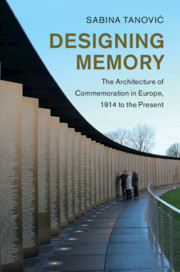
-
Select format
-
- Publisher:
- Cambridge University Press
- Publication date:
- 08 November 2019
- 28 November 2019
- ISBN:
- 9781108760577
- 9781108486521
- 9781108707824
- Dimensions:
- (247 x 174 mm)
- Weight & Pages:
- 0.72kg, 368 Pages
- Dimensions:
- (244 x 170 mm)
- Weight & Pages:
- 0.514kg, 288 Pages
You may already have access via personal or institutional login
Book description
This innovative study of memorial architecture investigates how design can translate memories of human loss into tangible structures, creating spaces for remembering. Using approaches from history, psychology, anthropology and sociology, Sabina Tanović explores purposes behind creating contemporary memorials in a given location, their translation into architectural concepts, their materialisation in the face of social and political challenges, and their influence on the transmission of memory. Covering the period from the First World War to the present, she looks at memorials such as the Holocaust museums in Mechelen and Drancy, as well as memorials for the victims of terrorist attacks, to unravel the private and public role of memorial architecture and the possibilities of architecture as a form of agency in remembering and dealing with a difficult past. The result is a distinctive contribution to the literature on history and memory, and on architecture as a link to the past.
Awards
Shortlist, 2021 First Book Award, The Memory Studies Association
Reviews
‘In this book a practising architect surveys the history of the design, the construction and the use of war memorials and monuments to the victims of war over the last century. A strikingly original study of the visualisation of memory, this book is essential reading for all those engaged in the cultural history of war and peace in our times.'
Jay Winter - Yale University, Connecticut
‘Designing Memory dramatically deepens our critical understanding of both the aesthetics and politics of ‘commemorative architecture' since 1914. Tanović's exceptional command of the theory and practice of memorial design brings an incisive new voice to the debates and discussions informing memorial design processes in Europe and the United States. An excellent new study – highly recommended.'
James E. Young - University of Massachusetts, Amherst
‘This extremely rich and thought-provoking work tells why and how memorial architecture has during the past decades come to deal with materialising mourning and trauma in space. Her challenging book offers crucial new insights into the way fragmented memories of multiple atrocities – from the Holocaust to slavery and terrorism – are moulded into universal architectural forms, and why the balance is often wrong.'
Rob van der Laarse - Universiteit van Amsterdam and Vrije Universiteit Amsterdam
‘A fascinating insight into the meaning behind our memorials – where design intent has to mediate personal psychology, politics and collective experience. Tanović is especially good on the ambiguous philosophical underpinning of an art and architecture practice that too often superficially rests on its laurels without questioning its own assumptions.'
Robert Bevan - author of The Destruction of Memory
Contents
Metrics
Altmetric attention score
Full text views
Full text views help Loading metrics...
Loading metrics...
* Views captured on Cambridge Core between #date#. This data will be updated every 24 hours.
Usage data cannot currently be displayed.
Accessibility standard: Unknown
Why this information is here
This section outlines the accessibility features of this content - including support for screen readers, full keyboard navigation and high-contrast display options. This may not be relevant for you.
Accessibility Information
Accessibility compliance for the PDF of this book is currently unknown and may be updated in the future.


